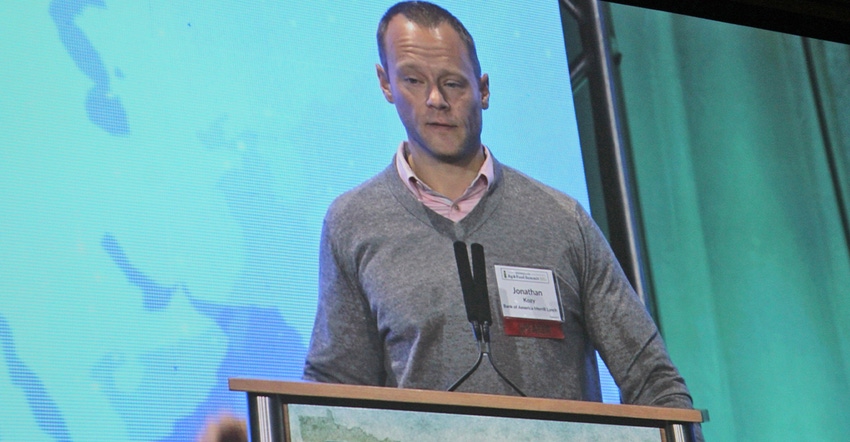
The U.S. is in the midst of its longest-ever business expansion, but there are flashing red lights that a recession looms in the next year or two, Jonathan Kozy told the 330 people gathered Nov. 7 for the Ag and Food Summit hosted by Minnesota AgriGrowth Council at the Minneapolis Convention Center.
Kozy, a senior vice president and senior macro strategy analyst for the Bank of America corporation, said the next recession could be preceded by companies pulling back on capital expenditures. A recession is more likely to be on the corporate side than the consumer side, he said. Historically, recessions are milder if they are isolated in one sector.
He acknowledged that there are four warning signs:
1. Growth has slowed across globe. Global economic growth is slowing with the U.S. doing better than the rest of the world. European growth ranges from 0% to 1%. Japan growth is at 1% as it is in Central and Latin America. Social unrest can be tied to a lack of jobs and lack of economic growth, he said.
2. Interest rates havespiked. The Federal Reserve raised interest rates too fast, making liquidity feel much tighter. Kozy is hopeful the Federal Reserve will cut interest rates in December and again early next year. While the Fed may not cut rates, the bar for raising rates has risen.
3. Profit margins have peaked. Profit margins peaked in 2014 and historically a couple years later a recession occurs. Companies margins are under pressure because of wage pressure.
4. Recessions are fueled by uncertainty. Most recessions occur in the first year of a presidential cycle because of the uncertainty surrounding a regime change. This suggests a recession is more likely in 2021. Also, the ongoing trade war has elevated uncertainty.
He also noted the positives:
The U.S. consumer is a $14.5 trillion market, with the U.S. consumer alone bigger than the Chinese economy by some metrics. U.S. consumers were slow to take on debt following the Great Recession and are in pretty good shape financially. Consumers will likely continue to do OK in the absence of massive job layoffs.
There is demand in the housing market because millennials have delayed getting married and becoming parents. However, they are now in the stage of life where they are moving to single-family houses and fueling this market.
The labor market participation rate is rising, pulling people off the bench into the workforce.
Inflation is running around 1.5% to 2%, which some economists call the Goldilocks scenario as it isn't too hot or too cold.
Kubat Willette is a Farm Progress digital content creator.
About the Author(s)
You May Also Like




